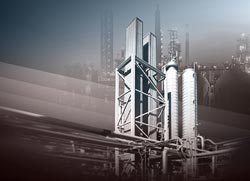Siemens delivers yet another wet air oxidation system to Sinopec

The most recent of seven Zimpro WAO systems installed at Sinopec facilities will be used to treat sulfidic spent caustic wastewater streams generated in the production of petrochemicals.
The WAO system is designed to eliminate odorous sulfide pollutants and generate a biodegradable effluent that can be discharged to conventional biological wastewater treatment. Using the Siemens technology will help make petrochemical production more environmentally friendly. The Yangzi system will treat approximately 4 m3/hr (17.6 gpm) of wastewater. The system is anticipated to be operational by the end of 2012.
Wet oxidation is the oxidation of soluble or suspended components in an aqueous environment using oxygen as the oxidizing agent. When air is used as the source of oxygen, the process is referred to as wet air oxidation (WAO). The process will oxidize odorous reduced sulfur species such as sulfides and mercaptides. The system will also break down complex organic contaminants, such as phenols, to either carbon dioxide and water, or biodegradable organics.
The Yangzi facility includes both a refinery and a petrochemical plant where fuels and ethylene are produced. This Sinopec project marks the ninth Zimpro WAO system installed by Siemens Water Technologies in China for spent caustic treatment.
Sinopec Yangzi Petrochemical Company Limited is a wholly-owned subsidiary under China Petroleum & Chemical Corporation. The company is mainly engaged in refining crude oil as well as in producing and marketing hydrocarbon derivatives. At present, the company operates more than 60 sets of large-scale petrochemical units and produces more than 9 million t/a products, covering over 60 varieties in five categories, i.e. polyolefin plastics, polyester feedstock, basic organic chemical raw materials, product oil, and synthetic rubber.
The Siemens Industry Sector (Erlangen, Germany) is the world's leading supplier of innovative and environmentally friendly products and solutions for industrial customers. With end-to-end automation technology and industrial software, solid vertical-market expertise, and technology-based services, the Sector enhances its customers' productivity, efficiency, and flexibility. With a global workforce of more than 100,000 employees, the Industry Sector comprises the Divisions Industry Automation, Drive Technologies and Customer Services as well as the Business Unit Metals Technologies. For more information, visit http://www.siemens.com/industry
The Siemens Industry Automation Division (Nuremberg, Germany) supports the entire value chain of its industrial customers – from product design to production and services – with an unmatched combination of automation technology, industrial control technology, and industrial software. With its software solutions, the Division can shorten the time-to-market of new products by up to 50 percent. Industry Automation comprises five Business Units: Industrial Automation Systems, Control Components and Systems Engineering, Sensors and Communications, Siemens PLM Software, and Water Technologies. For more information, visit http://www.siemens.com/industryautomation
Zimpro is a trademark of Siemens and/or its affiliates in some countries.
Reference Number: IIA2012032817e
Contact
Mr. Peter Jefimiec
Industry Automation Division
Siemens AG
Gleiwitzerstr. 555
90475 Nuremberg
Germany
Tel: +49 (911) 895-7975
peter.jefimiec@siemens.com
Contact USA
Ms. Allison Britt
Water Technologies Business Unit
Siemens Industry, Inc.
Hoffman Estates
IL 60192
USA
Tel: +1 (847) 713-8477
allison.britt@siemens.com
Media Contact
More Information:
http://www.siemens.com/waterAll latest news from the category: Corporate News
Newest articles

NASA: Mystery of life’s handedness deepens
The mystery of why life uses molecules with specific orientations has deepened with a NASA-funded discovery that RNA — a key molecule thought to have potentially held the instructions for…

What are the effects of historic lithium mining on water quality?
Study reveals low levels of common contaminants but high levels of other elements in waters associated with an abandoned lithium mine. Lithium ore and mining waste from a historic lithium…

Quantum-inspired design boosts efficiency of heat-to-electricity conversion
Rice engineers take unconventional route to improving thermophotovoltaic systems. Researchers at Rice University have found a new way to improve a key element of thermophotovoltaic (TPV) systems, which convert heat…



